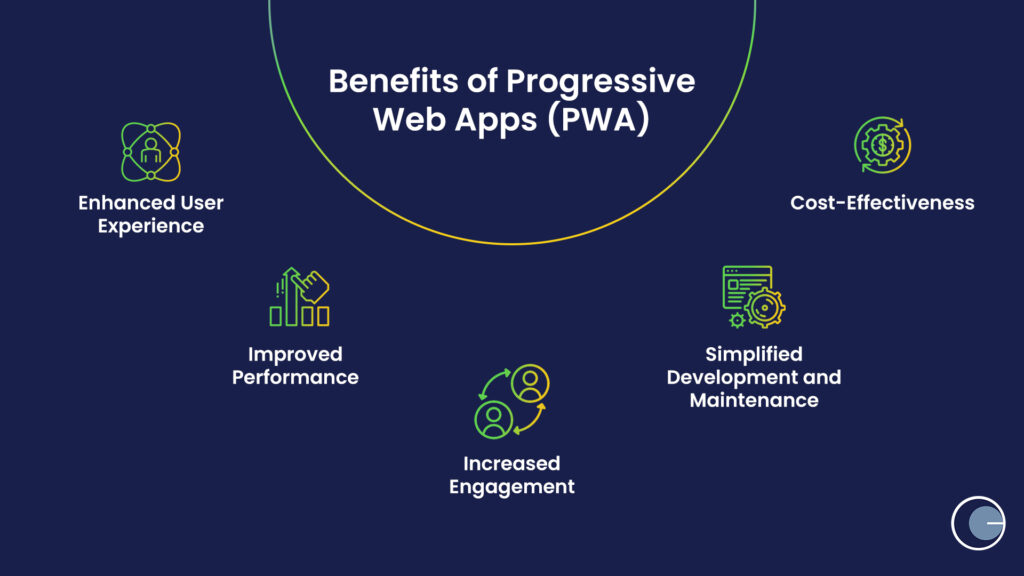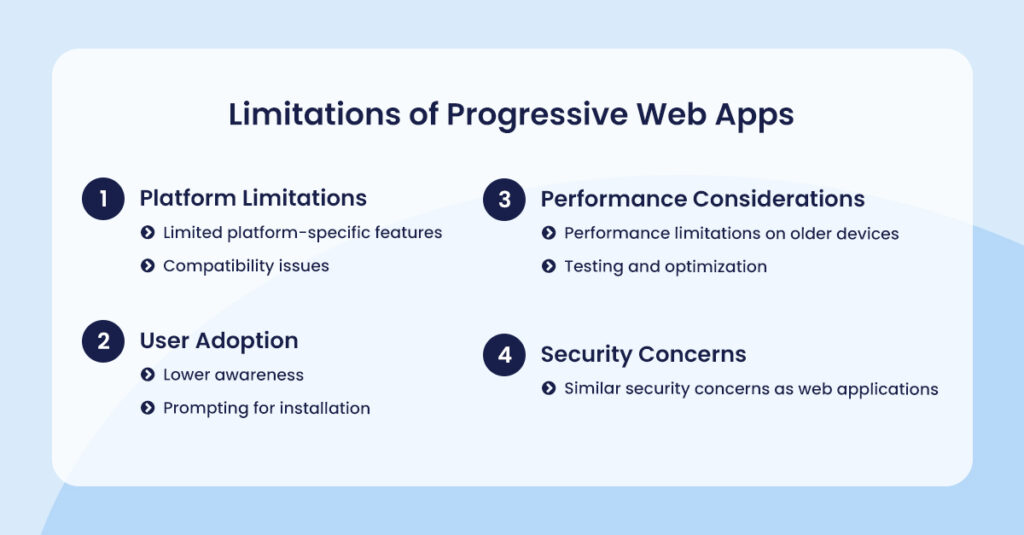Progressive Web Apps (PWAs) are a type of web application that combines the best features of both native apps and traditional websites. They offer a seamless user experience, leveraging modern web technologies to deliver app-like functionalities directly in a web browser.
Key characteristics of PWAs include:
- Installability: PWAs can be added to the user’s home screen, providing a native-like experience with icons and app-style launch.
- Offline functionality: They can cache essential content and resources, allowing them to function even without an internet connection.
- Push notifications: PWAs can send real-time notifications to users, keeping them engaged and informed.
The adoption of PWAs has been steadily increasing in recent years. Businesses and developers are recognizing the benefits of PWAs in providing a superior user experience, improving engagement, and reducing development costs. With advancements in web technologies and browser support, PWAs are becoming a viable alternative to traditional native apps across various platforms and devices.
Advantages of Progressive Web Apps (PWAs)

Enhanced User Experience:
- Native-like experience: PWAs offer a near-native app experience, with features like home screen icons, full-screen mode, and offline functionality. This provides users with a familiar and intuitive interface.
- Offline functionality: PWAs can cache essential content and resources, allowing them to function even without an internet connection. This is particularly beneficial for users in areas with unreliable or limited connectivity.
Improved Performance:
- Faster load times: PWAs are optimized for performance, with features like service workers and app shells that enable faster initial load times. This provides a more responsive and enjoyable user experience.
- Optimized for mobile devices: PWAs are designed to work seamlessly on mobile devices, adapting to different screen sizes and orientations. This ensures a consistent experience across various platforms.
Increased Engagement:
- Push notifications: PWAs can send targeted push notifications to users, keeping them informed about updates, promotions, or relevant content. This helps to increase user engagement and retention.
- Improved discoverability: PWAs can be indexed by search engines, making them easier for users to find and discover. This can lead to increased traffic and visibility.
Simplified Development and Maintenance:
- Web technologies: PWAs are built using standard web technologies like HTML, CSS, and JavaScript. This simplifies the development process and reduces the learning curve for developers.
- Cross-platform compatibility: PWAs can work across different platforms and devices, including iOS, Android, and desktop browsers. This eliminates the need for separate development efforts for each platform.
- Reduced maintenance costs: PWAs often require less maintenance compared to native apps, as updates can be deployed more easily and efficiently.
Cost-Effectiveness:
- Lower development costs: Developing PWAs can be more cost-effective than native apps, as there’s no need to create separate versions for each platform.
- Wider reach: PWAs can reach a wider audience by being accessible through web browsers on various devices. This can help to increase user acquisition and revenue.
Disadvantages of Progressive Web Apps (PWAs)

Platform Limitations:
- Limited platform-specific features: While PWAs offer many native-like features, there may be some platform-specific functionalities that are limited or unavailable. For example, PWAs might not have access to certain hardware features like the camera or accelerometer, or they might not be able to integrate with specific platform APIs. This can restrict the capabilities of PWAs compared to fully native apps.
- Compatibility issues: PWAs may encounter compatibility issues with older browsers or devices, especially those that don’t support the latest web standards. This can limit their reach and functionality. For instance, some PWAs might require specific browser features or support for service workers, which might not be available on older devices or browsers.
User Adoption:
- Lower awareness: User awareness and adoption of PWAs may still be relatively low compared to traditional native apps. Many users may not be familiar with the concept of PWAs or the benefits they offer. This can hinder their widespread adoption.
- Prompting for installation: Users may need to be prompted to install a PWA, which can sometimes be a barrier to adoption. This can be especially challenging on mobile devices, where users may be hesitant to install new apps.
Performance Considerations:
- Performance limitations on older devices: While PWAs are generally performant, they may experience some limitations on older devices or with complex PWAs. For instance, older devices might not have the processing power or memory to handle complex PWAs efficiently. This can lead to slower load times or reduced performance.
- Testing and optimization: PWAs require thorough testing and optimization to ensure they perform well across different devices and network conditions. This can be time-consuming and require specialized skills.
Security Concerns:
PWAs, in spite of offering many advantages, share similar security concerns as traditional web applications. These concerns arise from their nature as web-based applications that run within a browser.
Here are some of the key security risks associated with PWAs:
Cross-Site Scripting (XSS)
XSS attacks occur when malicious code is injected into a web page and executed by the user’s browser. This can lead to unauthorized access to user data, session hijacking, or other malicious activities. To mitigate XSS risks, PWAs should implement proper input validation, output encoding, and content security policies.
Cross-Site Request Forgery (CSRF)
CSRF attacks exploit the trust relationship between a user and a web application to force the user to perform unwanted actions. This can result in unauthorized actions on the user’s behalf, such as transferring funds or making purchases. PWAs should use CSRF tokens to verify that requests originate from the user’s browser and not from an attacker.
Injection Attacks
Injection attacks, such as SQL injection and command injection, occur when malicious code is injected into user input and executed by the application. These attacks can compromise the integrity of the application’s data and functionality. PWAs should use parameterized queries and prepared statements to prevent injection attacks.
Phishing Attacks
Phishing attacks attempt to trick users into revealing sensitive information, such as login credentials or credit card details. PWAs should implement strong authentication mechanisms, such as multi-factor authentication, to protect against these attacks.
Malware and Viruses
PWAs can be infected with malware or viruses just like any other web application. To mitigate this risk, PWAs should be regularly updated with security patches, scanned for malware, and protected with antivirus software.
Data Breaches
They may be vulnerable to data breaches if sensitive user data is not stored and transmitted securely. To protect against data breaches, PWAs should use encryption to secure data in transit and at rest, implement access controls to restrict access to sensitive data, and regularly monitor for unauthorized access attempts.
Social Engineering Attacks
Social engineering attacks exploit human psychology to trick users into revealing sensitive information or performing unauthorized actions. PWAs should educate users about the risks of these attacks and provide guidance on how to avoid falling victim to them.
Implementing Robust Security Measures
To address these security concerns, PWAs should implement robust security measures, including:
- Input validation and output encoding: Validate user input to prevent malicious code injection and encode output to prevent XSS attacks.
- CSRF protection: Use CSRF tokens to verify the authenticity of requests.
- Injection prevention: Use parameterized queries and prepared statements to prevent injection attacks.
- Strong authentication: Implement strong authentication mechanisms, such as multi-factor authentication.
- Regular updates and patching: Keep the PWA and its dependencies up-to-date with the latest security patches.
- Malware scanning: Regularly scan the PWA for malware and viruses.
- Data encryption: Use encryption to protect sensitive data in transit and at rest.
- Access controls: Implement access controls to restrict access to sensitive data.
- Security monitoring: Regularly monitor for unauthorized access attempts and security breaches.
- User education: Educate users about security best practices and the risks of social engineering attacks.
Best Practices for Developing and Optimizing PWAs
To ensure that your PWAs deliver the best possible user experience and performance, it’s essential to follow these best practices:
- Focus on performance: Optimize your PWA for speed and responsiveness, using techniques such as code minification, image compression, and caching.
- Prioritize offline functionality: Ensure that your PWA can function offline by caching essential content and resources.
- Leverage service workers: Use service workers to handle background tasks, improve performance, and enable offline functionality.
- Provide a seamless user experience: Design your PWA with a consistent and intuitive user interface, and ensure that it works well on different devices and screen sizes.
- Test thoroughly: Thoroughly test your PWA on various devices and browsers to identify and address any compatibility issues.
- Implement security measures: Protect your PWA from security threats by implementing robust security measures, such as input validation, output encoding, CSRF protection and more listed above.
PWAs have been shown to be extremely beneficial, with research from Simicart finding that after installing a PWA, the average time spent on-site increases by 119%. Not only that, but the average duration spent reading a page increases by 68.8%.
Conclusion: Charter Global’s Commitment to PWA Development
At Charter Global, we are committed to helping businesses leverage the power of PWAs to deliver exceptional digital experiences. Our team of skilled developers has extensive experience in building high-performance, user-friendly PWAs that meet the needs of our clients.
By partnering with Charter Global, you can benefit from our expertise in PWA development, including:
- Customized PWA solutions: We will work closely with you to understand your specific requirements and develop a PWA that meets your unique needs.
- Performance optimization: We’ll optimize your PWA for speed and responsiveness, ensuring a seamless user experience.
- Security best practices: We’ll implement robust security measures to protect your PWA and user data.
- Ongoing support and maintenance: We also provide ongoing support and maintenance to ensure that your PWA remains up-to-date and secure.
Contact us today to learn more about how Charter Global can help you leverage the power of PWAs and deliver exceptional digital experiences.
Book your consultation now.
Or email us at sales@charterglobal.com or call +1 770.326.9933

